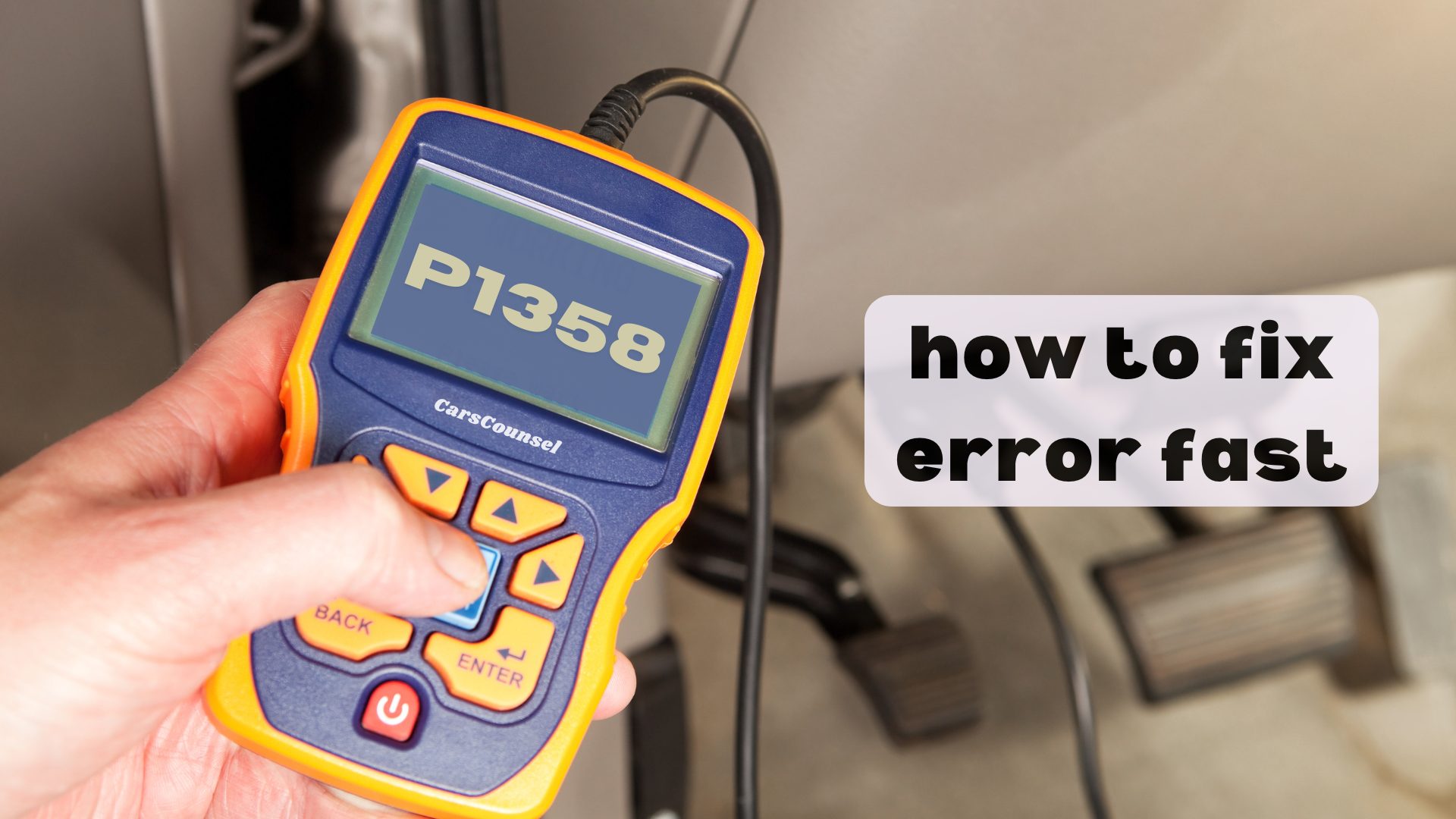You’re faced with the P1358 code, which means your Ignition Diagnostic Monitor Signal is out of whack. What does that even mean? Simply put, it’s a sign that your ignition system is malfunctioning, causing issues like engine misfires, rough idling, and poor fuel efficiency.
But don’t worry, you’re not stuck in the dark. By understanding the common causes, symptoms, and diagnosis procedures, you’ll be well on your way to fixing the problem and getting your vehicle running smoothly again.
But first, you’ll need to identify the root cause – is it a faulty ignition coil, damaged spark plug, or something else entirely?

Quick Navigation
Key Takeaways
- The P1358 code indicates a fault in the ignition system’s operation, specifically the Ignition Diagnostic Monitor Signal being out of self-test range.
- Common causes include faulty ignition coils, damaged spark plugs, wiring issues, and malfunctioning ignition control modules.
- Symptoms may include engine misfires, rough idling, illuminated Check Engine Light, decreased fuel efficiency, and reduced engine power output.
- To diagnose and fix the issue, use an OBD-II scanner to retrieve the DTC, inspect ignition system components, and replace faulty parts as needed.
- The average repair cost for a P1358 issue can range from $100 to $300, including parts and labor, depending on the specific cause and shop rates.
Code P1358 Description and Meaning
When your Ford vehicle’s On-Board Diagnostic (OBD) system detects a fault or discrepancy in the ignition system’s operation, it triggers the P1358 diagnostic trouble code (DTC).
This fault code indicates that the Ignition Diagnostic Monitor Signal is out of the self-test range. The Ignition Diagnostic Monitor (IDM) is a component of the OBD system that monitors the ignition system’s performance.
If the IDM signal is out of range, it means the OBD system has detected a fault or discrepancy in the ignition system’s operation. This can lead to issues with engine performance, fuel efficiency, and emissions.
As a result, you may experience reduced vehicle performance, including engine misfires, rough idling, or decreased fuel efficiency.
Common Causes of the P1358 Code
Faulty ignition system components are the primary culprits behind the P1358 code.
As you diagnose the issue, you’ll likely find that Spark Plug Wear or Ignition Failure are contributing factors.
- Faulty Ignition Coil: A malfunctioning ignition coil can disrupt the ignition system’s operation, leading to the P1358 code.
- Damaged Spark Plugs: Worn out or fouled spark plugs can cause ignition failure, triggering the code.
- Wiring Issues in the Ignition System: Corrosion, shorts, or broken wires can prevent the ignition system from functioning properly.
- Malfunctioning Ignition Control Module: A faulty ignition control module can send incorrect signals, resulting in the P1358 code.
Symptoms of Ignition Diagnostic Monitor Fault
Frequently, drivers notice a decline in engine performance when the Ignition Diagnostic Monitor (IDM) fault triggers the P1358 code.
You may experience engine misfires or rough idling, which can be attributed to spark plug issues or faulty ignition coils. As a result, your engine’s power output may be reduced, leading to decreased fuel efficiency.
Additionally, the Check Engine Light on your dashboard will likely illuminate, indicating that there’s an issue with your vehicle’s ignition system.
Paying attention to these symptoms can help you identify the problem early on and prevent further damage to your engine.
Diagnosing and Fixing the P1358 Issue
To diagnose and fix the P1358 issue, you’ll need to follow a systematic approach to identify the root cause of the problem.
As a Ford vehicle owner, it’s essential to understand that this code is specific to your ignition system.
To fix the issue, follow these steps:
- Use an OBD-II scanner to retrieve the specific DTC and identify the source of the issue.
- Inspect the ignition system components, such as the ignition coil and spark plugs, for any signs of damage or wear.
- Replace any faulty ignition components identified during the inspection.
- Clear the DTC and reset the OBD system to see if the issue has been resolved.
Repair Cost and Labor Estimates
In terms of repairing a P1358 code, one of the most significant concerns is the cost.
You’ll want to know how much you’ll need to shell out to get your vehicle running smoothly again. The average repair cost for a P1358 issue can range from $100 to $300, including parts and labor.
However, this amount can vary depending on the specific cause of the problem, your vehicle’s make and model, and the shop’s labor rates.
If you have warranty coverage, you may be able to reduce or even eliminate the cost.
Additionally, choosing a shop with extensive experience in ignition system repairs can also impact the final bill.
Be sure to get quotes from multiple shops to find the best deal.
Replacing Faulty Ignition System Components
When troubleshooting a P1358 code, you’ll often find that faulty ignition system components are the root cause of the problem.
To fix the issue, you’ll need to identify and replace the malfunctioning parts.
- Spark Plugs: Worn out or fouled spark plugs can cause ignition system issues. Consider Spark Plug Replacement to guarantee proper engine performance.
- Ignition Coil: A faulty ignition coil can prevent the spark plugs from firing correctly. An Ignition Coil Upgrade may be necessary to resolve the problem.
- Ignition Wires: Damaged or corroded ignition wires can disrupt the ignition system’s operation. Inspect and replace them as needed.
- Ignition Control Module: In some cases, the ignition control module may be malfunctioning, requiring replacement to restore proper ignition system function.
Replace these components as needed, and then clear the P1358 code to see if the issue has been resolved.
Clearing the P1358 Code and Resetting OBD
After replacing the faulty ignition system components, you’re ready to clear the P1358 code and reset the OBD system. This step is vital to guarantee the code doesn’t reappear and to confirm the issue has been resolved.
| Step | Description |
|---|---|
| 1 | Connect an OBD-II scanner to the vehicle’s onboard diagnostics port |
| 2 | Select the “Erase Codes” or “Clear Codes” option on the scanner |
| 3 | Follow the scanner’s instructions to complete the code reset |
Once you’ve cleared the code, reset the OBD system by disconnecting the battery for at least 30 minutes or using a code reset tool. This will allow the OBD system to relearn the ignition system’s parameters and guarantee proper operation.
Additional Resources for P1358 Troubleshooting
For efficient P1358 troubleshooting, you’ll want to utilize a range of resources to guarantee accurate diagnosis and repair.
They include:
- Ford Repair Tips: Consult Ford’s official repair manuals and guides for specific troubleshooting procedures and repair recommendations.
- Diagnostic Tools: Invest in advanced diagnostic tools, such as OBD-II scanners, to retrieve detailed trouble codes and live data.
- Online Forums: Join online forums and discussion groups dedicated to Ford vehicles to connect with experienced mechanics and owners who’ve encountered similar issues.
- Factory Service Manuals: Access factory service manuals for detailed diagrams, wiring schematics, and technical specifications to aid in your repair.
More OBD-II Codes
Frequently Asked Questions
Can a Faulty Oxygen Sensor Trigger a P1358 Code?
You’re wondering if a faulty oxygen sensor can trigger a P1358 code. While sensor failure can cause issues, it’s unlikely to directly trigger this code, which is specifically related to ignition troubles, such as faulty coils or spark plugs, affecting engine performance.
Will a P1358 Code Cause My Vehicle to Stall?
Your vehicle is like a delicate dance, where every component moves in harmony; but when ignition issues arise, stalling patterns can emerge, and a P1358 code can be the catalyst, causing your engine to sputter and stall, leaving you stranded.
Can I Drive Safely With a P1358 Code Illuminated?
When driving with an illuminated P1358 code, you should exercise caution, as ignition system issues can cause stalling or loss of power. Take driving precautions, such as avoiding heavy loads and high speeds, to minimize risks until you can have the issue professionally diagnosed and repaired.
Does a P1358 Code Affect Vehicle Emissions Testing?
When you’re preparing for emissions testing, a faulty ignition system can impact your vehicle’s performance, potentially leading to a failed test. You’ll need to address the underlying issue to guarantee your vehicle meets testing requirements, as a malfunctioning ignition system can increase emissions and affect test results.
Will a Tune-Up Fix a P1358 Code?
You’re wondering if a tune-up will fix the P1358 code; however, it depends on the underlying cause. If spark plug wear or faulty ignition coils are the culprits, a tune-up might resolve the issue, but fuel injector cleaning alone is unlikely to fix the problem.
Conclusion
You’ve finally conquered the P1358 code, the nemesis of smooth engine operation! By now, you’ve diagnosed and fixed the faulty ignition system component, cleared the code, and reset your OBD. Pat yourself on the back, because you’ve just saved yourself from a world of engine misfires, rough idling, and fuel efficiency nightmares! With your newfound expertise, you’re ready to take on any ignition system issue that comes your way.

